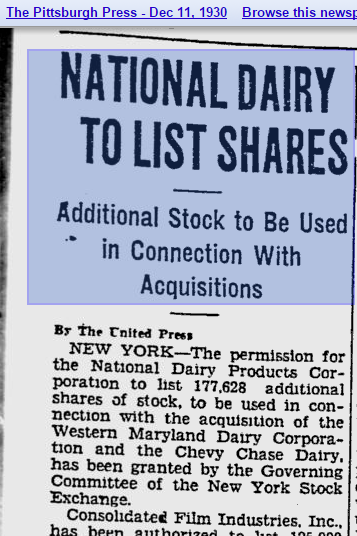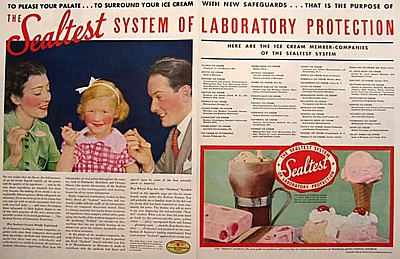Fairfield Farms Dairy Cooling Station Detour
Need for Sanitary Milk Handling
-
Orange County Goshen Butter by rail
During the 19th century New York was widely renowned for its robust dairy industry.
The state was a leader in the production of milk, cheese, and butter.
Milk production in New York was first in the nation for an extended period.
All during the 19th century and into the early 20th century New York led the nation in the amount of milk it produced.
In 1840, for example, New York accounted for 31% of the total value of U.S. dairy products
The first regular supply of butter for the New York City market was manufactured in Orange County and bordering portions of Sussex County, New Jersey.
Since Goshen was at the center of this area and was the Orange County seat, this butter became known as “Goshen Butter” and was famous around the country.
The Orange county farmers had built up a highly profitable trade in butter and had made a national reputation for it.
Butter keeps much better than milk and is well suited for long journeys to market.
This was a natural incentive to direct as much milk as possible to butter production.
When the railroads finally entered the scene, the genuine “Goshen Butter” trade of Orange and Sussex Counties rapidly declined.
The railroads dramatically reduced the time it took to move dairy products to market making milk transport to the city viable.
Making butter took more effort than simply shipping raw milk and the “Goshen Butter” farmers abandoned the butter trade in droves.
-
NYC Swill milk (brewery-dairy conspiracy) scandal
The Swill milk scandal was a major adulterated food (impure, unsafe, or unwholesome food) scandal in New York in the 1850s.
The New York Times reported an estimate that 8,000 infants died one year from swill milk.
The milk drawn from the cows was routinely adulterated with water, rotten eggs, flour, burnt sugar and other adulterants with
the finished product then marketed falsely as "pure country milk" or "Orange County Milk".
Michael Tuomey successfully blocked any serious inquiry into the dairies and stymied calls for reform. The Board of Health exonerated the distillers,
but public outcry led to the passage of the first food safety laws in the form of milk regulations in 1862.
-
Pasteurization
In 1864 French scientist Louis Pasteur discovered that heating beer and wine was enough to kill most of the bacteria
that caused spoilage, preventing these beverages from turning sour
Before the widespread urban growth caused by industrialization, people kept dairy cows even in urban areas and
the short time period between production and consumption minimized the disease risk of drinking raw milk.
As urban densities increased and supply chains lengthened to the distance from country to city,
raw milk (often days old) became recognised as a source of disease.
For example, between 1912 and 1937 some 65,000 people died of tuberculosis contracted from consuming milk in England and Wales alone.
Developed countries adopted milk pasteurization to prevent such disease and loss of life,
and as a result milk is now widely considered one of the safest foods.
-
Sheffield Farms (brought Pasteurization to U.S.)
L. B. Halsey, a lawyer who married Sarah Frances Sheffield became interested in the dairy business when called upon to help deliver his widowed mother-in-law’s butter.
Through careful selection and breeding the Sheffield herd of Mahwah, New Jersey, produced superior milk, which in turn made fine butter.
He began marketing the butter in his spare time in the city and by 1880 had given up the law to devote himself to the dairy trade.
His first innovation was to design a covered milk wagon that protected fluid milk from dust.
Halsey trained other farmers to improve the quality of their milk and bought milk only from the best herds.
In 1892, he installed the first pasteurizing machine in the United States, imported from Germany, at Sheffield Farms’ Bloomville, New York, plant.
The following year, pasteurization was demonstrated at the Columbian Exposition in Chicago. Commercial milk pasteurization was introduced in Baltimore in 1893
but Cincinnati is credited with the first large scale pasteurization program in America.
New York followed in 1898, although pasteurization was not yet required for some years.
National Dairy Products was formed in 1923 as a merger of several dairy concerns and continued to grow through acquisitions,
the most important of which was the addition of Sheffield Farms.
Fairfield Farms Dairy - Western Maryland Dairy - National Dairy Corporation - Anti-Trust
- how did the stock market crash affect the dairy/company?

- https://en.wikipedia.org/wiki/Mondelez_International
Mondelez International is former Kraft Foods Inc after October 2012
Cadbury Purchase: On September 7, 2009 Kraft made a hostile £10.2 billion takeover bid for the British confectionery group Cadbury, makers of Dairy Milk and Bournville chocolate.
On November 9 the company's bid (then £9.8 billion) was rejected by Cadbury, which called it a "derisory" offer. Kraft renewed the offer on December 4.
It had significant political and public opposition in the United Kingdom and abroad,
leading to a call for the government to implement economic protectionism in large-company takeovers.
On January 19, 2010, Cadbury approved a revised offer from Kraft which valued the company at £11.5 billion ($19.5 billion).
Some funds for the takeover were provided by the Royal Bank of Scotland, the British partially state-owned bank.
In 1933, National Dairy began advertising on radio. Two years later Sealtest ice cream was introduced as a national brand, replacing the company's regional brands.
https://www.pinterest.com/pin/350577152219866304/
http://www.atticpaper.com/proddetail.php?prod=1935-sealtest-ad-list-of-stores&cat=33

Nancy J saved to Ice Cream 1935 Vintage Sealtest Ice Cream Ad ~ List of Stores, Vintage Food ...
National Dairy acquisition of Kraft-Phenix
At the 1930 acquisition National Dairy had sales of $315 million, compared with $85 million for Kraft Phenix. National Dairy management ran the company.
After the acquisition the company was known as National Dairy until 1969, when it was renamed Kraftco.
Although the company's sales were historically dairy products, its product lines began to diversify from dairy products to caramel candies, macaroni-and-cheese dinners and margarine.
During the 1950s, it began to move away from low-value-added-commodity dairy products such as fluid milk.
National Dairy becomes Kraft
In 1969, National Dairy changed its name to Kraftco Corporation: "Expansion and innovation have taken us far afield from the regional milk and ice cream business we started with in 1923.
Dollar sales of these original products have remained relatively static over the past ten years and, in 1969 accounted for approximately 25% of our sales."
National Dairy Products Corporation (National Dairy), which was founded on December 10, 1923, by Thomas H. McInnerney.
McInnerney operated the Hydrox Corporation, a Chicago ice-cream company. In 1923 he went to Wall Street
http://www.library.hbs.edu/hc/lehman/company.html?company=national_dairy_products_corporation
The National Dairy Products Corporation was organized in New York City and incorporated in Delaware in December 1923.
It was formed for the purpose of acquiring the common stock of the Rieck-McJunkin Dairy Company of Pittsburgh and the Hydrox Corporation of Chicago,
two of the largest manufacturers and distributors of ice cream and dairy products in the United States.
Management of the new company was made up the heads of both acquired firms:
Edward E. Rieck, President of Rieck-McJunkin, who became chairman of National Dairy, and
Thomas McInnerney, president of Hydrox, who became president of the new firm.
In 1956 the company acquired Metro Glass Company, a maker of glass containers used by National Dairy.
http://bellefonte.net/wp-content/uploads/2008/08/dairy.pdf
1920 Irvin D. Baxter, proprietor of the Western Maryland Dairy Company based in Baltimore, Maryland.
In 1956, “separate corporate existence of the Sheffield Farms Company, Inc., terminated and all of the estate, property, rights, privileges, and franchises of Sheffield Farms Company, Inc.
became vested in and were held and enjoyed by National Dairy Products Corporation.”
Tax Cases - Fairfield Farms and Western Maryland Dairy

U.S. Tax Cases, Volume 94, Issue 1 - 1935-42 decisions originally reported currently in the Standard federal tax service
1927 Simplifed Practice for Milk Bottles and Bottle Caps NBS accepted by Fairfield and WM still separate
Investigation of Concentration of Economic Power, Part 7 - U.S. Government Printing Office, 1939 - Antitrust investigations - 18489 pages



E-books transcript
a letter dated March 24, 1934, from Walter T. Coe of Thurmont, Maryland, to the Maryland State Dairymen's Association in Baltimore advising
that he had purchased a 50-acre farm in Creagerstown in 1932 with the expectation of sending milk to the Detour, Maryland plant,
operated by Fairfield-Western Maryland Dairy Company, and that he (Mr. Coe) would like to have a basic allocation for producing and selling milk in Baltimore.
I. W. Heaps, Manager of the Association, wrote Mr. Coe on March 27, 1934, in part:
"Replying to your very nice letter of the 24th, I wish to say first I sincerely
sympathize with you in your desire to begin shipping milk, and yet T am placed
in the position of being powerless to help you under the Baltimore Milk Market
license issued by the Secretary of Agriculture. The only thing I can suggest is
that you buy a herd of cows already producing milk for this market,..."
- Sherman Anti-Trust Act
Until the late 1800s the federal government encouraged the growth of big business.
By the end of the century, however, the emergence of powerful trusts began to threaten the U.S. business climate.
Trusts were corporate holding companies that, by 1888, had consolidated a very large share of U.S. manufacturing and mining industries into nationwide monopolies.
The trusts found that through consolidation they could charge Monopoly prices and thus make excessive profits and large financial gains.
Access to greater political power at state and national levels led to further economic benefits for the trusts, such as tariffs or discriminatory railroad rates or rebates.
The most notorious of the trusts were the Sugar Trust, the Whisky Trust, the Cordage Trust, the Beef Trust, the Tobacco Trust,
John D. Rockefeller's Oil Trust (Standard Oil of New Jersey), and J. P. Morgan's Steel Trust (U.S. Steel Corporation).
Consumers, workers, farmers, and other suppliers were directly hurt monetarily as a result of the monopolizations.
Even more important, perhaps, was that the trusts fanned into renewed flame a traditional U.S. fear and hatred of unchecked power,
whether political or economic, and particularly of monopolies that ended or threatened equal opportunity for all businesses.
The public demanded legislative action, which prompted Congress, in 1890, to pass the Sherman Act.
President Theodore Roosevelt promoted the antitrust cause, calling himself a "trustbuster."
In 1914, Congress established the Federal Trade Commission (FTC)
to formalize rules for fair trade and to investigate and curtail unfair trade practices.
During the 1920s, enforcement efforts were more modest, and during much of the 1930s,
the national recovery program of the New Deal encouraged industrial collaboration rather than competition.
During the late 1930s, an intensive enforcement of antitrust laws was undertaken.
Commission Suggests Repeal of 1930s Antitrust Law APRIL 3, 2007 Here we go again...
recommended the repeal of a 1930s-era antitrust law designed to protect small retailers,
Robinson-Patman Act - Congress passed the act in 1936 with the idea of leveling the playing field between small businesses and chain discount stores.
Created: 11-03-2017 09:53AM
Modified: 11-03-2017 12:38PM
Modified: 11-15-2017 09:41AM
Last Update:




